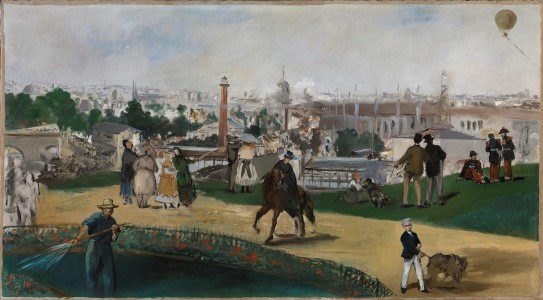View of the 1867 Exposition Universelle
Édouard Manet
Transcription
Narrator:
One passenger on the tethered hot-air balloon could be Edouard Manet’s photographer friend Felix Nadar, perhaps with a client who has paid to see Paris and the World Fair from the air. On the ground below, in an enormous, elliptical exhibition complex, France and the other participating countries are displaying all their respective countries have to offer.
Trading agreements are being signed; objects are changing hands.
A world fair was also an opportunity for artists to raise their profiles and find larger markets for their work.
At that time, Paris lay at the heart of European culture and commerce with its hyper-modern art, architecture, fashion, department stores, concerts, entertainment and urban life.
Edouard Manet's paintings of modern life, with their identifiable models, provoked public outrage. Manet was among the younger painters who were challenging the academic tradition championed at the conservative Paris Salon, the annual exhibition of French contemporary art.
Manet had been rejected many times by the Salon.
In 1867, he took matters into his own hands. He had an eighteen-metre-long temporary pavilion constructed next to the World Fair, on a piece of high ground known as the Trocadero.
Here he exhibited fifty-six of his own works. In a manifesto-like text, he wrote:
"Exhibiting is a matter of life and death for an artist.
Exhibiting is about finding friends and allies for the battle."
Manet failed to sell any of his pictures.
Looking down on the world’s most important arena, the largest world fair yet becomes a bit-part player in Manet’s depiction of a single moment in modern Paris that year.